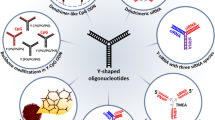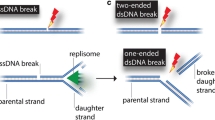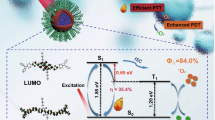Abstract
Photooxidative damage was induced predominantly at a single guanine base in a target DNA by irradiation (λ > 330 nm) in the presence of complementary oligodeoxynucleotide conjugates (ODN-5′-linker-[Ru(phen)3]2+) (phen = 1,10-phenanthroline). The target DNA represents the b2a2 variant of the chimeric bcr-abl gene implicated in the pathogenesis of chronic myeloid leukaemia, and the sequence of the 17mer ODN component of the conjugate (3′ G G T A G T T A T T C C T T C T T 5′) was complementary to the junction region of the sense strand sequence of this oncogene. Two different conjugates were prepared, both of them by reaction of the appropriate succinimide ester with 5′-hexylamino-derivatised 17mer ODN. In Ru—ODN-1 (7) the linker was—(CH2)6-NHCO-bpyMe (-bpyMe = 4′-[4-methyl-2,2′-bipyridyl]), whereas in Ru—ODN-2 (13) it was—(CH2)6-NHCO—(CH2)3-CONH-phen. Photoexcitation of either of the conjugates when hybridised with the 32P-5′-end-labelled target 34mer 5′T G A C̲ C̲ A̲ T̲ C̲ A̲ A̲ T̲ A̲ A̲ G̲ G̲ A̲ A̲ G̲ A̲ A̲ G21 C C C T T C A G C G G C C 3′ (ODN binding site underlined) led to an alkali-labile site predominantly (> 90%) at the G21 base, which is at the junction of double-stranded and single-stranded regions of the hybrid. Greater yields were found with Ru—ODN-1 (7) than with Ru—ODN-2 (13). In contrast to this specific cleavage with Ru—ODN-1 (7) or Ru—ODN-2 (13), alkali-labile sites were generated at all guanines when the 34mer was photolysed in the presence of the free sensitiser [Ru(phen)3]2+. Since [Ru(phen)3]2+ was shown to react with 2′-deoxyguanosine to form the diastereomers of a spiroiminodihydantoin derivative (the product from 1O2 reaction), 1O2 might also be an oxidizing species in the case of Ru—ODN-1 (7) and Ru—ODN-2 (13). Therefore to determine the range of reaction, a series of ‘variant’ targets was prepared, in which G21 was replaced with a cytosine and a guanine substituted for a base further towards the 3′-end (e.g. Variant 3; 5′T G A C C A T C A A T A A G G A A G A A C C G23 C T T C A G C G G32 C C 3′). While it was noted that efficient reaction took place at distances apparently remote from the photosensitiser (e.g. at G32, but not G23 for Variant 3), this effect could be attributed to hairpinning of the single-stranded region of the target. These results are therefore consistent with the photooxidative damage being induced by a reaction close to the photosensitiser rather than by a diffusible species such as 1O2.
Similar content being viewed by others
References
K. E. Erikkila, D. T. Odom, J. K. Barton, Recognition and reaction of metallointercalators with DNA, Chem. Rev., 1999, 99, 2777–2795.
B. Nordén, P. Lincoln, B. Akerman and E. Tuite, Probing of nucleic acids by metal ion complexes of small molecules, in Metal Ions in Biological Systems, ed. A. Sigel and H. Sigel, Marcel Dekker, New York, 1996, vol. 33, pp. 177–252.
T. Da Ros, G. Spalluto, A. S. Boutorine, R. V. Bensasson, M. Prato, DNA-photocleavage agents, Curr. Pharm. Des., 2001, 7, 1781–1821.
C. Moucheron, A. Kirsch-De Mesmaeker, J. M. Kelly, Photoreactions of ruthenium(II) and osmium(II) complexes with deoxyribonucleic acid (DNA), J. Photochem. Photobiol. B., 1997, 40, 91–106.
C. Moucheron, A. Kirsch-De Mesmaeker, J. M. Kelly, Photophysics and photochemistry of metal polypyridyl and related complexes with nucleic acids, Struct. Bonding, 1998, 92, 163–216.
J. M. Kelly, A. B. Tossi, D. J. McConnell, C. OhUigin, A study of the interactions of some polypyridylruthenium(II) complexes with DNA using fluorescence spectroscopy, topoisomerisation and thermal denaturation, Nucleic Acid Research, 1985, 13, 6017–6034
A. B. Tossi, J. M. Kelly, A study of some polypyridylruthenium(II) complexes as DNA binders and photocleavage reagents, Photochem. Photobiol., 1989, 49, 545–556.
A. Aboul-Enein, D. Schulte-Frohlinde, Biological deactivation and single-strand breakage of plasmid DNA by photosensitization using tris(2,2′-bipyridyl)ruthenium(II) and peroxydisulfate, Photochem. Photobiol., 1988, 48, 27–34.
C. Sentage, J. C. Chambron, J. P. Sauvage, N. Paillous, Tuning the mechanism of DNA cleavage photosensitized by ruthenium dipyridophenazine complexes by varying the structure of the two non intercalating ligands, J. Photochem. Photobiol. B., 1994, 26, 165–174.
J. M. Kelly, A. B. Tossi, D. J. McConnell, C. OhUigin, C. Hélène and T. le Doan, Interaction of ruthenium polypyridyl complexes with DNA and their use as sensitisers for its cleavage, in Free Radicals, Metal Ions and Biopolymers, ed. P. C. Beaumont, D. J. Deeble, B. J. Parsons and C. Rice Evans, Richelieu Press, London, 1989, p. 143.
S. Delaney, M. Pascaly, P. K. Bhattacharya, K. Han, J. K. Barton, Oxidative damage by ruthenium complexes containing the dipyridophenazine ligand or its derivatives: a focus on intercalation, Inorg. Chem., 2002, 41, 1966–1974.
L. Jaquet, R. J. H. Davies, A. Kirsch-De Mesmaeker, J. M. Kelly, Photoaddition of [Ru(tap)2(bpy)]2+ to DNA: A new mode of covalent attachment of metal complexes to duplex DNA, J. Am. Chem. Soc., 1997, 119, 11763–11768.
J-P. Lecomte, A. Kirsch-De Mesmaeker, M. M. Feeney, J. M. Kelly, Ruthenium(II) complexes with 1,4,5,8,9,12-hexaazatriphenylene and 1,4,5,8-tetraazaphenanthrene ligands: key role played by the photoelectron transfer in DNA cleavage and adduct formation, Inorg. Chem., 1995, 34, 6481–6491.
Y. Jenkins, J. K. Barton, A sequence-specific molecular light switch: tethering of an oligonucleotide to a dipyridophenazine complex of ruthenium(II), J. Am. Chem. Soc., 1992, 114, 8736–8738.
X. Hu, G. D. Smith, M. Sykora, S. J. Lee, M. W. Grinstaff, Automated solid-phase synthesis and photophysical properties of oligodeoxynucleotides labeled at 5′-aminothymidine with Ru(bpy)2(4-m-4′-cam-bpy)2+, Inorg. Chem., 2000, 39, 2500–2504.
D. J. Hurley, Y. Tor, Metal-containing oligonucleotides: solid-phase synthesis and luminescence properties, J. Am. Chem. Soc., 1998, 120, 2194–2195.
E. Meggers, D. Kusch, B. Giese, An effective synthesis of enantiomerically pure Δ- and Λ-ruthenium(II) labelled oligonucleotides, Helv. Chim. Acta., 1997, 80, 640–652.
D. Ossipov, P. I. Pradeepkumar, M. Holmer, J. Chattopadhyaya, Synthesis of [Ru(phen)2dppz]2+-tethered oligo-DNA and studies on the metallointercalation mode into the DNA duplex, J. Am. Chem. Soc., 2001, 123, 3551–3562.
W. Bannwarth, D. Schmidt, R. L. Stallard, C. Hornung, R. Knorr, F. Müller, Bathophenanthroline-ruthenium(II) complexes as non-radioactive labels for oligonucleotides which can be measured by time-resolved fluorescence techniques, Helv. Chim. Acta., 1988, 71, 2085–2099.
J. Telser, A. Cruickshank, K. S. Schanze, T. L. Netzel, DNA oligomers and duplexes containing a covalently attached derivative of tris (2, 2′ -bipyridine) ruthenium(II): synthesis and characterization by thermodynamic and optical spectroscopic measurements, J. Am. Chem. Soc., 1989, 111, 7221–7226.
G. N. Grimm, A. S. Boutorine, P. Lincoln, B. Nordén, C. Hélène, Formation of DNA triple helices by an oligonucleotide conjugated to a fluorescent ruthenium complex, ChemBioChem., 2002, 3, 324–331.
D. García-Fresnadillo, N. Boutonnet, S. Schumm, C. Moucheron, A. Kirsch-De Mesmaeker, E. Defrancq, J. F. Constant, J. Lhomme, Luminescence quenching of Ru-labeled oligonucleotides by targeted complementary strands, Biophys. J., 2002, 82, 978–987.
S. Schumm, M. Prévost, D. García-Fresnadillo, O. Lentzen, C. Moucheron, A. Kirsch-De Mesmaeker, Influence of the sequence dependent ionisation potentials of guanines on the luminescence quenching of Ru-labeled oligonucleotides: a theoretical and experimental study, J. Phys. Chem. B, 2002, 106, 2763–2768.
C. G. Coates, J. J. McGarvey, P. L. Callaghan, M. Colleti, J. G. Hamilton, Probing the interaction of [Ru(phen)2dppz]2+ with single-stranded DNA–what degree of protection is required for operation of the “light-switch effect”?, J. Phys. Chem. B, 2001, 105, 730–735.
P. K. Bhattacharya, J. K. Barton, Influence of intervening mismatches on long-range guanine oxidation in DNA duplexes, J. Am. Chem. Soc., 2001, 123, 8649–8656.
I. Ortmans, S. Content, N. Boutonnet, A. Kirsch-De Mesmaeker, W. Bannwarth, J-F. Constant, E. Defrancq, J. Lhomme, Ru-labeled oligonucleotides for photoinduced reactions on targeted DNA guanines, Chem. Eur. J., 1999, 5, 2712–2721.
R. E. Clarke, Antisense therapeutics in chronic myeloid leukaemia: the promise, the progress and the problems, Leukaemia, 2000, 14, 347–355.
A. Hergueta-Bravo, M. E. Jiménez-Hernández, F. Montero, E. Oliveros, G. Orellana, Singlet oxygen-mediated DNA photocleavage with Ru(II) polypyridyl complexes, J. Phys. Chem. B, 2002, 106, 4010–4017.
F. Schubert, A. Knaf, U. Möller, D. Cech, Covalent attachment of methylene blue to oligonucleotides, Nucleosides Nucleotides, 1995, 14, 1437–1443.
S. I. Khan, A. E. Beilstein, G. D. Smith, M. Sykora, M. W. Grinstaff, Synthesis and excited-state properties of a novel ruthenium nucleoside: 5-[Ru(bpy)2(4-m-4′-pa-bpy)]2+-deoxyuridine, Inorg. Chem., 1999, 38, 2411–2415.
J. Feely, P. V. Kavanagh, S. M. McNamara, J. E. O’Brien, Simple preparation of the major urinary metabolites of flunitrazepam and nitrazepam, Iran. J. Med. Sci., 1999, 168, 8–9.
B. H. Han, D. H. Shin, S. Y. Cho, Graphite catalysed reduction of aromatic and aliphatic nitro compounds with hydrazine hydrate, Tetrahedron Lett., 1985, 26, 6233–6234.
N. Y. Sardesai, S. C. Lin, K. Zimmermann, J. K. Barton, Construction of coordinatively saturated rhodium complexes containing appended peptides, Bioconjugate Chem., 1995, 6, 302–312.
I. Saito, T. Nakamura, K. Natatani, Mapping of highest occupied molecular orbitals of duplex DNA by cobalt-mediated guanine oxidation, J. Am. Chem. Soc., 2000, 122, 3001–3006.
F. Wilkinson, W. P. Helman, A. B. Ross, Rate constants for the decay and reactions of the lowest electronically excited singlet-state of molecular-oxygen in solution-an expanded and revised compliation, J. Phys. Chem. Ref. Data, 1995, 24, 663–1021.
J. Van Houten, R. J. Watts, Temperature dependence of the photophysical and photochemical properties of the tris(2,2′-bipyridyl)ruthenium(II) ion in aqueous solution, J. Am. Chem. Soc., 1976, 98, 4853–4858.
J-L. Ravanat, T. Douki, M-F. Incardona, J. Cadet, HPLC separations of normal and modified nucleobases and nucleosides on an amino-silica gel column, J. Liq. Chromatogr., 1993, 36, 3185–3202.
J. Cadet and P. Vigny, in Bioorganic Chemistry, ed. H. Morrison, Wiley, New York, 1990, vol. 1, pp. 1–272.
J. C. Niles, J. S. Wishnok, S. R. Tannenbaum, Spiroimino-dihydantoin is the major product of the 8-oxo-7,8-dihydroguanosine reaction with peroxynitrite in the presence of thiols and guanosine photoxidation by methylene blue, Org. Lett., 2001, 3, 963–966.
W. Adam, M. A. Arnold, M. Grüne, W. M. Nau, U. Pischel, C. R. Saha-Müller, Spiroiminodihydantoin is a major product in the photooxidation of 2′-deoxyguanosine by the triplet states and oxyl radicals generated from hydroxyacetophenone photolysis and dioxetane thermolysis, Org. Lett., 2002, 4, 537–540.
T. Douki, J. Cadet, Modification of DNA bases by photosensitized one-electron oxidation, Int. J. Radiat. Biol., 1999, 75, 571–581.
B. Lewin, Genes V, Oxford University Press Inc., New York, 1994.
F. Prat, C-C. Hou, C. S. Foote, Determination of the quenching rate constants of singlet oxygen by derivatized nucleosides in nonaqueous solution, J. Am. Chem. Soc., 1997, 119, 5051–5052.
A. S. Boutorine, D. Brault, M. Takasugi, O. Delgado, C. Helene, Chlorin-oligonucleotide conjugates: synthesis, properties, and red light-induced photochemical sequence-specific DNA cleavage in duplexes and triplexes, J. Am. Chem. Soc., 1996, 118, 9469–9476.
I. V. Yang, H. H. Thorp, Kinetics of metal-mediated one-electron oxidation of guanine in polymeric DNA and in oligonucleotides containing trinucleotide repeat sequences, Inorg. Chem., 2000, 39, 4969–4976.
X. Y. Zhang, M. A. J. Rodgers, Energy and electron-transfer reactions of the MLCT state of ruthenium tris(bipyridyl) with molecular-oxygen–a laser flash-photolysis study, J. Phys. Chem., 1995, 99, 12797–12803.
B. P. Sullivan, D. J. Salmon, T. J. Meyer, Mixed phosphine 2,2′-bipyridine complexes of ruthenium, Inorg. Chem., 1978, 17, 3334–3341.
G. Sprintschnik, H. W. Sprintschnik, P. P. Kirsch, D. G. Whitten, Preparation and photochemical reactivity of surfactant ruthenium(II) complexes in monolayer assemblies and at water-solid interfaces, J. Am. Chem. Soc., 1977, 15, 4947–4954.
C. D. Ellis, L. D. Margerum, R. W. Murray, T. J. Meyer, Oxidative electropolymerization of polypyridyl complexes of ruthenium, Inorg. Chem., 1983, 22, 1283–1291.
E. Koft, F. H. Case, substituted 1,10-phenanthrolines, benzo and pyrido derivatives, J. Org. Chem., 1962, 27, 865–868.
T. Maniatis, E. F. Fritch, J. Sambrook, Molecular Cloning, a laboratory manual, 2nd edn., Cold Spring Harbour Lab, NY, 1989.
Author information
Authors and Affiliations
Corresponding author
Rights and permissions
About this article
Cite this article
Crean, C.W., Kavanagh, Y.T., O’Keeffe, C.M. et al. Targeting of photooxidative damage on single-stranded DNA representing the bcr-abl chimeric gene using oligonucleotide-conjugates containing [Ru(phen)3]2+-like photosensitiser groups. Photochem Photobiol Sci 1, 1024–1033 (2002). https://doi.org/10.1039/b207387k
Received:
Accepted:
Published:
Issue Date:
DOI: https://doi.org/10.1039/b207387k




